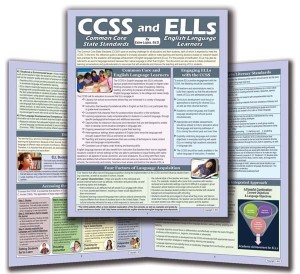Just-released laminated guide “ELLs: Thinking Skills and CCSS,” and guide “CCSS & ELLs,” help teachers prepare English Language Learners to meet Common Core State Standards for English Language Arts.
The Common Core State Standards (CCSS), by design, elevate academic rigor and further challenge educators and students, with the goal of better preparing them for the demands of college and career. The challenge is especially great for students or whom English is a second language, or English language learners (ELLs), and the teachers who are responsible for helping them meet core standards.
The Common Core State Standards for English Language Arts (CCSS-ELA) increase comprehension and language demands, requiring ELLs to learn language and grade-level content simultaneously and to use higher level thinking skills to activate their academic understanding of content or text. It is critical that teachers understand the CCSS-ELA and the “Six Shifts” in teaching/learning the ELA standards require, and that they utilize an array of evidence-based instructional approaches and best-practices that have been shown to help ELLs integrate academic language, literacy and cognition, and achieve the high and deep levels of learning articulated in the standards.
Dr. Estee Lopez’s laminated reference guides, CCSS and ELLs and the just-released ELLs: Thinking Skills and CCSS, are easy-access, quick-reference tools designed to help educators understand the CCSS-ELA, their implications for ELLs, and how to design instruction and utilize best practices to supports ELLs in developing critical thinking skills necessary to meet ELA standards.
 In ELLs: Thinking Skills and CCSS, Lopez identifies the six shifts of the CCSS-ELA, which include:
In ELLs: Thinking Skills and CCSS, Lopez identifies the six shifts of the CCSS-ELA, which include:
- Increasing reading of informational text/balancing informational and literary texts
- Knowledge in the disciplines
- Staircase of complexity
- Text-based answers
- Writing from sources
- Academic language
This six-page (tri-fold) laminated guide explains each shift, its implications for ELLs, and what is required of teachers. For each shift, the guide lists best practices, examples of scaffolding for ELLs, and things that teachers and administrators must to do create conditions that ensure that ELLs succeed.
 CCSS and ELLs, also a six-page (tri-fold) laminated guide, guide emphasizes the need for teachers and school leaders to:
CCSS and ELLs, also a six-page (tri-fold) laminated guide, guide emphasizes the need for teachers and school leaders to:
- Connect with ELL students and integrate them in meaningful learning experiences with other students;
- Implement curriculum and tasks that are cognitively demanding and include scaffolded strategies;
- Construct lessons that are interactive and collaborative;
- Recognize that families can have a positive effect on the education of ELLs.
It provides an at-a-glace overview off the CCSS for ELA, and identifies the six shifts that must be considered when deciding upon appropriate instruction, scaffolding and differentiation for English language learners. Corresponding best practices are listed for each shift. The guide also details a proven 4-phase, 7-step model for designing lesson plans that clearly and explicitly state content and learning objectives in order of importance.
With the explosion of the ELLs population in schools across the country, it is crucial for all teachers to have easy access to best practices for helping ELLs achieve content and learning objectives simultaneously and develop the critical thinking skills necessary to meet the CCSS for English Language Arts. Estee Lopez’s laminated guides, CCSS and ELLs and ELLs: Thinking Skills and CCSS, are practical and affordable tools that school administrators can provide to busy teachers who are grappling with the CCSS’s complex new criteria for teaching and learning to help them and their students succeed.









